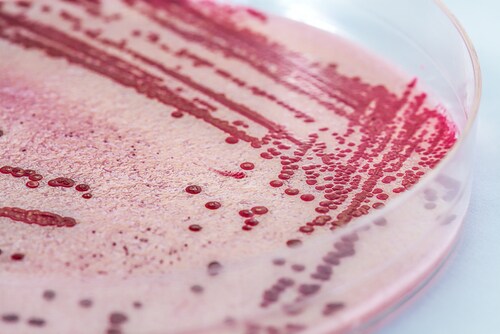 Listeriosis is a foodborne disease caused by Listeria monocytogenes (Lm), a rod-shaped, facultative, intracellular, Gram-positive bacterium. Ingesting contaminated food can cause gastroenteritis; however, Lm can also cross the intestinal barrier, infecting the spleen and liver, as well as the blood–brain barrier and the placenta. Even with prompt treatment, mortality is as high as 30%. In recent years, listeriosis incidence has been increasing, in line with our aging population. This is cause for concern because of the increased vulnerability of this group. Kummer et al. (2016) have used a murine model with a proteomics approach to investigate liver responses to infection.
Listeriosis is a foodborne disease caused by Listeria monocytogenes (Lm), a rod-shaped, facultative, intracellular, Gram-positive bacterium. Ingesting contaminated food can cause gastroenteritis; however, Lm can also cross the intestinal barrier, infecting the spleen and liver, as well as the blood–brain barrier and the placenta. Even with prompt treatment, mortality is as high as 30%. In recent years, listeriosis incidence has been increasing, in line with our aging population. This is cause for concern because of the increased vulnerability of this group. Kummer et al. (2016) have used a murine model with a proteomics approach to investigate liver responses to infection.
The researchers obtained a strain of Lm, which they used to intravenously infect female C57BL/6 mice. They then extracted and froze liver pieces at −80°C, after sacrifice at days one, three and nine postinoculation. Quantitative proteomic analysis on an UltiMate 3000 RSLC nano liquid chromatography system coupled to an Orbitrap Fusion Tribrid mass spectrometer (both Thermo Scientific) resulted in 3,666 proteins identified. Kummer et al. also identified the greatest protein upregulation (471) at day three postinoculation and found that the majority of proteins regulated at an individual or just two consecutive time points. They postulate that this discriminates the early (1–3 days) and late (3+ days) infection phases. In contrast, they only determined sustained downregulation for 15 proteins along days one, three and nine. A component of the cytochrome P450 (CYP450) system was among these.
In total, Kummer et al. identified 42 members of the CYP450 system, of which 25 were significantly downregulated at one or more time points. This suggests a systemic effect on the CYP450 enzymes by sublethal listeriosis. The vast majority of CYP450 members were significantly downregulated. This is significant because previous studies have described CYP450 enzyme downregulation to result in diminished drug-metabolizing enzyme activities in Lm infections.
The authors suggest that the reduction in enzyme levels as a result of Lm infection limits metabolic turnover and deregulates hepatic drug-metabolizing pathways. Therefore, Kummer et al. recommend monitoring drug administration through the course of Lm infections, particularly in patients requiring regular medication.
Reference
1. Kummer, A. (2016) “Listeriosis downregulates hepatic cytochrome P450 enzymes in sublethal murine infection,” Proteomics: Clinical Applications, doi: 10.1002/prca.201600030 [Epub ahead of print].
Leave a Reply